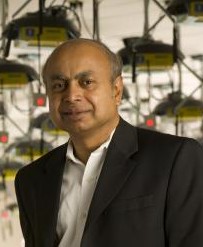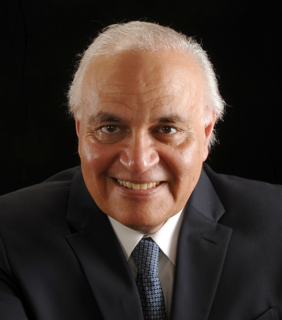Related Research Articles

Robert Gray Gallager is an American electrical engineer known for his work on information theory and communications networks. He was elected an IEEE Fellow in 1968, a member of the National Academy of Engineering (NAE) in 1979, a member of the National Academy of Sciences (NAS) in 1992, a Fellow of the American Academy of Arts and Sciences (AAAS) in 1999. He received the Claude E. Shannon Award from the IEEE Information Theory Society in 1983. He also received the IEEE Centennial Medal in 1984, the IEEE Medal of Honor in 1990 "For fundamental contributions to communications coding techniques", the Marconi Prize in 2003, and a Dijkstra Prize in 2004, among other honors. For most of his career he was a professor of electrical engineering and computer science at the Massachusetts Institute of Technology.

Rosalind Wright Picard is an American scholar and inventor who is Professor of Media Arts and Sciences at MIT, founder and director of the Affective Computing Research Group at the MIT Media Lab, and co-founder of the startups Affectiva and Empatica. In 2005, she was named a Fellow of the Institute of Electrical and Electronics Engineers for contributions to image and video analysis and affective computing. In 2019 she received one of the highest professional honors accorded an engineer, election to the National Academy of Engineering for her contributions on affective computing and wearable computing.
Lin Yi-bing or Jason Lin is a Taiwanese academic who has served as the Chair Professor of the Department of Computer Science and Information Engineering (CSIE) at National Chiao Tung University (NCTU) since 1995, and since 2002, the Chair Professor of the Department of Computer Science and Information Management (CSIM), at Providence University, a Catholic university in Taiwan. He also serves as Vice President of the National Chiao Tung University.
Arun N. Netravali is an Indian-American computer engineer credited with contributions in digital technology including HDTV. He conducted research in digital compression, signal processing and other fields. Netravali was the ninth President of Bell Laboratories and has served as Lucent's Chief Technology Officer and Chief Network Architect. He received his undergraduate degree from IIT Bombay, India, and an M.S. and a Ph.D. from Rice University in Houston, Texas, all in electrical engineering. Several global universities, including the Ecole Polytechnique Federale in Lausanne, Switzerland, have honored him with honorary doctorates.

Norman Manuel Abramson was an American engineer and computer scientist, most known for developing the ALOHAnet system for wireless computer communication.

Arogyaswami J. Paulraj is an Indian-American electrical engineer, academic. He is a Professor Emeritus in the Dept. of Elect. Engg. at Stanford University.
Sergio Verdú is a former professor of electrical engineering and specialist in information theory. Until September 22, 2018, he was the Eugene Higgins Professor of Electrical Engineering at Princeton University, where he taught and conducted research on information theory in the Information Sciences and Systems Group. He was also affiliated with the program in Applied and Computational Mathematics. He was dismissed from the faculty following a university investigation into his conduct in relation to university policies that prohibit consensual relations with students and require honesty and cooperation in university matters.

Ian F. Akyildiz is the Ken Byers Chair Professor with the School of Electrical and Computer Engineering (ECE) at Georgia Institute of Technology, the Director of the Broadband Wireless Networking (BWN) Laboratory and Chair of the Telecommunications Group at the School of ECE at Georgia Tech. According to Google Scholar, his H-index is 122 and the total number of citations to his papers is 116+K.
Stewart David Personick is an American researcher in telecommunications and computer networking. He worked at Bell Labs, TRW, and Bellcore, researching optical fiber receiver design, propagation in multi-mode optical fibers, time-domain reflectometry, and the end-to-end modeling of fiber-optic communication systems.
Krishan Sabnani is an Indian-American networking researcher. He has made many seminal contributions to the Internet infrastructure design, protocol design, and wireless networks. Krishan made a breakthrough in Internet re-design. The main idea behind this work was to separate control functions and complex software from the forwarding portions on Internet routers. This work made it possible for forwarding technologies to evolve and be deployed independently from control protocols. This contribution is a precursor to the current Software Defined Networking (SDN) revolution. A patent based on this work won the 2010 Edison Patent Award.
Jonathan Shields Turner is a senior professor of Computer Science in the School of Engineering and Applied Science at Washington University in St. Louis. His research interests include the design and analysis of high performance routers and switching systems, extensible communication networks via overlay networks, and probabilistic performance of heuristic algorithms for NP-complete problems.
Walter David "Dave" Sincoskie was an American computer engineer. Sincoskie installed the first ethernet local area network at Bellcore, and helped invent voice over IP technology. Sincoskie authored the first local ATM specification. He is also the inventor of the VLAN.
Professor Shlomo Shamai (Shitz) is a distinguished professor at the Department of Electrical engineering at the Technion − Israel Institute of Technology. Professor Shamai is an information theorist and winner of the 2011 Shannon Award.

Biswanath Mukherjee is an Indian and American Distinguished Professor of computer science at University of California, Davis and a fellow of IEEE.

Vijay K. Vaishnavi is a noted researcher and scholar in the computer information systems field with contributions mainly in the areas of design science research, software engineering, and data structures & algorithms, authoring over 150 publications including seven books in these and related areas, and co-owning a patent. He is currently Professor Emeritus at the Department of Computer Information Systems, Georgia State University. He is Senior Editor Emeritus of MIS Quarterly and is on the editorial boards of a number of other major journals. His research has been funded by the National Science Foundation (NSF) as well as by the industry.
Mootaz Elnozahy is a computer scientist. He is currently a professor of computer science and dean of the computer, electrical and mathematical science, and engineering division at King Abdullah University of Science and Technology. Elnozahy's research area is in systems, including high-performance computing, power-aware computing, fault tolerance, operating systems, system architecture, and distributed systems. His work on rollback-recovery is now a standard component of graduate courses in fault-tolerant computing, and he has made seminal contributions in checkpoint/restart, and in general on the complex hardware-software interactions in resilience.
Ranjan Kumar Mallik is an Indian electrical and communications engineer and a professor at the Department of Electrical Engineering of the Indian Institute of Technology, Delhi. He held the Jai Gupta Chair at IIT Delhi from 2007 to 2012 and the Brigadier Bhopinder Singh Chair from 2012 to 2017. He is known for his researches on multiple-input multi-output systems and is an elected fellow of all the three major Indian science academies viz. Indian Academy of Sciences, Indian National Science Academy, and The National Academy of Sciences, India. He is also an elected fellow of The World Academy of Sciences, Indian National Academy of Engineering, and The Institute of Electrical and Electronics Engineers, Inc.

Xi Zhang is a Full Professor and the Founding Director of the Networking and Information Systems Laboratory, Department of Electrical and Computer Engineering, Texas A&M University. He is a Fellow of the IEEE for contributions to quality of service (QoS) in mobile wireless networks. His research interests include statistical delay-bounded QoS provisioning for multimedia mobile wireless networks, edge computing, finite blocklength coding theory, in-network caching, and offloading over 5G mobile wireless networks.

Dipankar Raychaudhuri is the Director of Wireless Information Network Laboratory (WINLAB) and distinguished professor in the Electrical and Computer Engineering department at Rutgers University.

Moeness G. Amin is an Egyptian-American professor and engineer. Amin is the director of the Center for Advanced Communications and a professor in the Department of Electrical and Computer Engineering at Villanova University.
References
- ↑ "John O. Limb Patents". Patent Genius. Retrieved 2 January 2011.
- 1 2 "IEEE Global History Network - John O. Limb". IEEE . Retrieved 2 January 2011.
- 1 2 "Faculty people at Georgia Tech, College of Computing, Networking & Telecommunications Group". Georgia Institute of Technology College of Computing . Retrieved 2 January 2011. See section "Emeritus/Part Time Faculty", Prof. John Limb.
- ↑ U.S. Patent 4,129,882
- ↑ U.S. Patent 4,412,326
- ↑ U.S. Patent 7,245,621
- ↑ "The Communications Society Leonard G. Abraham Prize in the Field of Communications Systems". IEEE Communications Society . Retrieved 2 January 2011.
- ↑ "IEEE Donald G. Fink Prize Paper Award Recipients" (PDF). IEEE . Retrieved 2 January 2011.
- ↑ "IEEE Alexander Graham Bell Medal Recipients" (PDF). IEEE . Retrieved 2 January 2011.